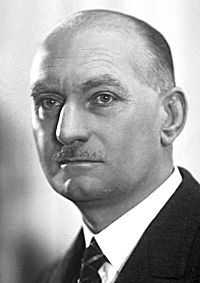Corneille Heymans facts for kids
Quick facts for kids
Corneille Heymans
|
|
|---|---|
 |
|
| Born | 28 March 1892 |
| Died | 18 July 1968 (aged 76) |
| Nationality | Belgian |
| Alma mater | Ghent University |
| Known for | Vascular Presso- and Chemo-Receptors in Respiratory Control (blood pressure) |
| Awards | Nobel Prize for Physiology or Medicine (1938) |
| Scientific career | |
| Fields | Physiology |
| Institutions | Ghent University |
| Notable students | Paul Janssen |
Corneille Jean François Heymans (born March 28, 1892 – died July 18, 1968) was a Belgian scientist who studied how the human body works. He was a physiologist, which means he studied how living things function. He went to the College of Saint Barbara and later to Ghent University, where he earned his doctor's degree in 1920.
Heymans won the famous Nobel Prize for Physiology or Medicine in 1938. He received this award for his amazing discovery of how our bodies measure blood pressure and the amount of oxygen in our blood. He showed how this information is sent to the brain.
Contents
Who Was Corneille Heymans?
After finishing his studies, Corneille Heymans worked at several important universities around the world. He learned from many different professors. In 1922, he started teaching about how medicines affect the body at Ghent University.
Later, in 1930, he took over from his father, Jean-François Heymans, as a professor. He became the head of a special department that studied medicines and how they affect the body. He also directed the J. F. Heymans Institute.
Amazing Discoveries About Your Body
Corneille Heymans received the Nobel Prize for Physiology or Medicine in 1938. His big discovery was about how our bodies keep track of our blood pressure and the oxygen levels in our blood. He proved that this information is sent to the brain through nerves, not through the blood itself.
How Your Body Checks Blood Pressure
To make this discovery, Heymans used a special scientific setup. He showed that certain parts of the body, like the carotid sinus (a small area in your neck's main artery), have tiny sensors. These sensors are called baroreceptors. They detect changes in blood pressure.
When blood pressure changes, these sensors send signals through nerves, like the vagus nerve, directly to the brain. This tells the brain if your blood pressure is too high or too low.
The Carotid Body's Secret
Heymans also studied how our bodies control breathing. He found that tiny structures called chemoreceptors in the carotid body (another small area near the carotid sinus) detect the amount of oxygen in the blood. If oxygen levels drop, these chemoreceptors send signals to the brain. This makes you breathe faster or deeper to get more oxygen.
A Spanish scientist named Fernando de Castro Rodríguez helped a lot with this research. He carefully described the nerves in the aorta-carotid area. His detailed work helped Heymans and his team focus on the tiny carotid body. This led to their important discovery about how our bodies sense oxygen.
Heymans was also the main editor for a science journal for many years. He was a member of several important science groups, including the Pontifical Academy of Sciences.
Life Outside Work
Corneille Heymans married Berthe May in 1929. She was an eye doctor. They had five children together. Heymans passed away in Knokke in 1968 after having a stroke.
Awards and Recognition
- Heymans (crater) on the Moon (named after him!)
- Nobel Prize for Physiology or Medicine (1938)
- Member, American Philosophical Society (1962)
See also
 In Spanish: Corneille Heymans para niños
In Spanish: Corneille Heymans para niños

